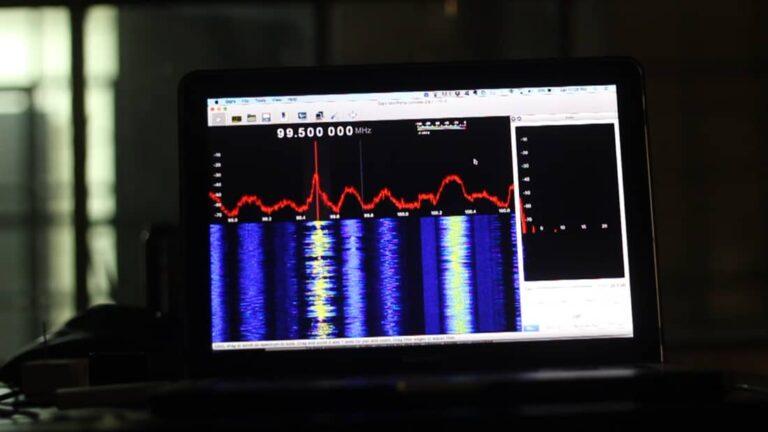
In today’s interconnected world, radio signals and wireless networks play a crucial role in how devices communicate, from smartphones and IoT gadgets to critical infrastructure. However, this convenience also brings serious security risks. Cybercriminals can exploit RF vulnerabilities to steal sensitive data, disrupt business operations, or even compromise critical systems like power grids, vehicles, and aviation networks.
As businesses and individuals focus on protecting computers and mobile devices from cyber threats, RF-based attacks often go unnoticed—making them a silent but growing risk.
But what exactly are radio signals, and how do they impact cybersecurity? More importantly, how can you protect your data from RF threats? This guide explores the risks, real-world attack methods, and proven strategies to safeguard your business from radio signal vulnerabilities.
Topics
RF Threats & Cybersecurity Protection : Understanding the Risks
The Growing Importance of Cybersecurity in the Era of Radio Signals & Wireless Technology
How Cyber Attacks Exploit Radio Signals
Effective Ways to Prevent Cyber Attacks : Free Tips & Recommended Tools for Enhanced Protection
RF Threats & Cybersecurity Protection : Understanding the Risks
Radio signals are used for a variety of functions, from wireless communication to common technologies like AM/FM signals, Wi-Fi (2.4GHz), and Bluetooth. While these signals are generally safe and commonly used in homes without issue, they also pose a hidden security risk.
Many devices, such as computers, smartphones, and IoT gadgets, rely on radio signals to connect to Wi-Fi or Bluetooth networks. Unfortunately, this connectivity can be hijacked by cyber attackers seeking to gain unauthorized access to networks and devices, creating a need for special protection against such threats.
Cybersecurity threats aren’t always immediately obvious, as hackers are continuously evolving their methods to infiltrate systems. One such method gaining prominence is the use of radio signals for RF-based attacks—also known as wireless attacks. These attacks exploit vulnerabilities in radio frequency communication, which is often overlooked in standard security protocols.
A recent example comes from Ben Gurion University’s research, where security experts found that cyber attackers can exploit wireless networks, including Bluetooth, by transmitting counterfeit radio signals. Devices, such as computers and smartphones, are often programmed to automatically connect to networks via Wi-Fi or Bluetooth without user intervention, leaving them vulnerable to attacks like the ‘man-in-the-middle’ attack.
During this type of attack, hackers can intercept or even control devices remotely by exploiting these vulnerabilities. Once the attack is successful, the hacked computer or Bluetooth-enabled device can be used by attackers to access sensitive data or launch further attacks within the network.
As more devices and networks rely on wireless technology like Bluetooth and Wi-Fi, it’s crucial to understand the risks associated with radio frequency-based attacks and take steps to protect your data from these emerging threats.
The Growing Importance of Cybersecurity in the Era of Radio Signals & Wireless Technology
Cybersecurity is no longer confined to protecting computers and mobile devices from digital threats. With the rise of wireless technology and its rapid adoption across all sectors, it’s essential to understand how radio signals play a significant role in your organization’s cybersecurity strategy.
In today’s connected world, technologies like Wi-Fi, Bluetooth, and IoT devices are powered by radio signals that are susceptible to various cyber threats. As we increasingly depend on these technologies for communication, there’s a pressing need to address the cyber risks posed by these radio waves.
You may not realize how much your business or home network is exposed to potential risks from radio signals. Understanding the link between wireless communication and cybersecurity is key to mitigating those risks. Here are three essential facts about cybersecurity and radio wave threats that every business owner and IT professional should know:
Rising Threats to Devices via Radio Signals
The use of radio signals in communication opens the door to a growing range of cyber threats. Wireless technologies like Wi-Fi and Bluetooth are essential in our daily lives but can also be targeted by cybercriminals. These signals can be intercepted or hijacked, leading to potential security breaches. While it’s difficult to define exactly what constitutes an attack on radio signals, the risk of unauthorized access is a growing concern for businesses and consumers alike.Invisible Threats from Radio Waves
Radio signals can be invisible and often go undetected, which makes it harder to spot attacks before they cause harm. Devices like computers and smartphones are often programmed to automatically connect to Wi-Fi or Bluetooth without user intervention. This can leave systems vulnerable to attacks like man-in-the-middle and RF-based exploits, where attackers intercept or control data without the user’s knowledge.Emerging Risks of Wireless Technology
As wireless technology continues to advance, so do the potential vulnerabilities that come with it. Devices ranging from smartphones to IoT gadgets and wireless printers can be compromised via their radio signals. Cybersecurity needs to evolve to keep pace with the expanding use of wireless technology and to mitigate the threats posed by these radio wave vulnerabilities.
With the increasing dependence on wireless communication, it’s critical to understand the risks associated with radio signal threats and take proactive steps to secure your devices and networks from potential attacks. We’ve compiled a list of common radio signal-related vulnerabilities and effective protection strategies to help you safeguard your data and infrastructure.
Dangers from Radio signals
Radio waves are powerful, but they’re also very useful—for example, they’re used in Bluetooth technology.
But what if you could use radio signals to launch a cyber attack? Well, it turns out that there is some risk of a cyberattack via radio transmissions.
Here are some of the dangers of radio signals that we need to be aware of cyberattacks through electronic devices.
1. Stealing data from unprotected computers
2. connection to malware via hidden repeaters or spyware
3. Unintentional connections between wireless devices and nefarious users
4.Wireless access points controlled by others
5. Third-party control of networks or data centers (this includes poorly protected connections)
6. Unauthorized surveillance due to poorly secured cameras
How do you protect against these kinds of attacks?
How Cyber Attacks Exploit Radio Signals
Cybercriminals are increasingly using radio signals to exploit vulnerabilities in digital communication systems. Here’s how these attacks work and why they are a growing concern:
- Radio Signals Can Pass Through Obstacles
Radio signals, unlike wired connections, can easily travel through walls, buildings, and other barriers. This makes it incredibly difficult to detect when a signal is compromised or being exploited.
Explanation : Whether it’s your Wi-Fi network or Bluetooth devices, attackers can intercept and manipulate signals from a distance without leaving physical traces.
2. Rogue Access Points and Fake Cell Towers
Hackers can set up rogue access points or IMSI catchers (fake cell towers) to trick devices into connecting to them, allowing the attacker to intercept or manipulate data.
Explanation : By mimicking legitimate access points or cell towers, attackers can gain unauthorized access to private networks, steal personal information, or launch attacks.
3. Man-in-the-Middle (MITM) Attacks
These attacks occur when hackers place themselves between two communicating devices (like your phone and a Wi-Fi router) to secretly intercept and manipulate the data being exchanged.
Explanation : Through MITM attacks, attackers can eavesdrop on confidential information or inject malicious code into otherwise secure communications, all without the user’s knowledge.
4. Hidden Surveillance Devices
Cybercriminals can plant RF-based surveillance devices, such as hidden cameras and microphones, that transmit data without being detected.
Explanation : These devices can be placed in homes, offices, or public spaces to spy on individuals, gather sensitive information, or even gain access to secure systems.
5. Devices Are Constantly Listening for Signals
Many devices, such as smartphones, laptops, and IoT gadgets, are designed to automatically listen for signals like Wi-Fi or Bluetooth. This can leave them vulnerable to attacks if the signals they are tuned into are manipulated or faked.
Explanation : When devices automatically seek out connections to these signals, hackers can exploit this behavior to send counterfeit signals, tricking devices into connecting to malicious networks or systems.
These RF-based threats highlight the increasing complexity of modern cyberattacks, especially as they occur outside traditional network defenses like firewalls or antivirus software. Understanding these risks is crucial to protecting both personal and business data from evolving attack methods.
Effective Ways to Prevent Cyber Attacks : Free Tips & Recommended Tools for Enhanced Protection
In today’s digital landscape, cyber attacks are not just a possibility but a constant reality. Hackers exploit vulnerabilities in networks, wireless communications, and connected devices to steal data, disrupt operations, and compromise security. While implementing foundational cybersecurity practices is crucial, modern threats require advanced detection tools to counter increasingly sophisticated attacks.
Below, we’ll explore free cybersecurity tips and how RF detectors and specialized software—like CAM-GX5, Piranha-500, WAM-X10, iProtect 1217, and BH04—play a vital role in identifying and neutralizing cyber threats before they cause harm.
1. Strengthen Your Network Security
Hackers frequently exploit network vulnerabilities to gain unauthorized access. Firewalls serve as your first line of defense, filtering out malicious traffic before it reaches your system. However, traditional firewalls may not be enough when attackers use RF (radio frequency) signals to breach your security.
✅ Free Tip: Use software firewalls like ZoneAlarm or Comodo Firewall for additional protection.
✅ Advanced Protection: The WAM-X10 Wireless Activity Monitor provides real-time scanning for unauthorized RF transmissions, detecting hidden Wi-Fi networks, Bluetooth signals, and GPS trackers that traditional cybersecurity software cannot see.
2. Monitor and Protect Your IP Address
Your IP address is a gateway to your personal or corporate data. Cybercriminals can use it to track your online activity, launch attacks, or bypass security protocols.
✅ Free Tip: Regularly check your IP address using network monitoring tools like Angry IP Scanner to identify unauthorized access attempts.
✅ Advanced Protection: The iProtect 1217 RF detector helps track unauthorized radio-based data transmissions that attempt to bypass network security by using hidden wireless connections. This ensures that even the most discreet cyber threats are identified.
3. Secure Your Wi-Fi & Detect Unwanted Wireless Threats
Public and even private Wi-Fi networks can be exploited for man-in-the-middle (MITM) attacks, where hackers intercept data between users and the internet. Standard network security may not detect sophisticated attacks that use rogue access points or hidden transmitters to infiltrate your systems.
✅ Free Tip: Always use a VPN (like ProtonVPN) when connecting to public Wi-Fi to encrypt your internet traffic.
✅ Advanced Protection: The CAM-GX5 Cellular Activity Monitor detects unauthorized Wi-Fi and Bluetooth transmissions, including hidden network activity and IMSI catchers (fake cell towers). This is crucial for preventing covert surveillance and unauthorized data access.
4. Identify and Eliminate RF-Based Cyber Threats
One of the most overlooked cyber risks comes from RF-based attacks, where hackers use radio signals to steal data, track devices, or inject malware without relying on internet connections. Traditional cybersecurity software cannot detect bugging devices, GPS trackers, or covert surveillance tools that operate using radio frequencies.
✅ Free Tip: Conduct regular physical inspections of workspaces and devices for unknown or suspicious hardware.
✅ Advanced Protection:
Piranha-500 is a portable RF detector specifically designed to locate and neutralize wireless surveillance threats, hidden microphones, and illicit listening devices.
BH04 Hybrid Bug Detector provides a dual-mode scanning system that detects both RF and wired eavesdropping devices, offering enhanced protection for high-security environments.
The Future of Cybersecurity Requires Proactive Measures
Cyber threats have evolved beyond traditional hacking methods—they now involve RF exploitation, wireless breaches, and covert surveillance. While software-based firewalls and VPNs are essential, they do not provide visibility into hidden wireless threats that operate outside conventional networks.
Investing in advanced detection tools like the CAM-GX5, Piranha-500, WAM-X10, iProtect 1217, and BH04 ensures that cybercriminals cannot use radio-based exploits to breach your security.
By integrating these tools into your cybersecurity strategy, you can proactively identify and eliminate threats before they become serious breaches.
secure your privacy and confidentiality from radio signals
These advanced features work together to strengthen defenses against hacking attempts through radio signals, ensuring a robust security system:
Detection of 2G/3G/4G/5G Signals:
- Identify and analyze different generations of mobile signals to spot potential vulnerabilities or unauthorized access.
Detection of DECT/Bluetooth/GSM/WLAN/WIFI/GPS:
- Identify various communication protocols, including wireless and Bluetooth technologies, offering broad coverage against potential threats.
3 Operation Modes (Search, Oscillograph, Security):
- Customize the device’s operations for specific needs, allowing searches, signal pattern analysis, and the implementation of enhanced security protocols.
Background Subtraction Function:
- Reduce interference by removing background signals, improving the accuracy of signal detection and lowering false positives.
4 Banks of Memory (2,000 signals per Bank):
- Store extensive signal data for analysis, providing historical information for threat assessment and incident response.
PDF Reporting – PC/MAC/Linux Compatible:
- Generate detailed reports in PDF format compatible with various operating systems for comprehensive analysis and documentation.
Acoustic Indication:
- Receive audible alerts for signal detection, ensuring real-time awareness and response to potential threats.
Probing Signal:
- Actively test and assess the security posture of the monitored environment using probing signals.
Antenna 1 – Frequency Range 10-2400 GHz:
- Cover a wide spectrum of frequencies to detect various signals and potential threats.
Antenna 2 – Frequency Range 2400-8000 GHz (High-Speed Channel):
- Extend coverage with a high-speed channel antenna for signals operating at higher frequencies.
Dynamic Range – Up to 70 dB:
- Achieve a high dynamic range for precise signal measurement, ensuring accurate detection and analysis.
High Sensitivity up to: -70 dBm (ANT 1) -50 dBm (ANT 2):
- Exhibit high sensitivity to detect even weak signals, enhancing overall security.
Built-in Frequency Meter – TURBO Frequency Identification:
- Use a built-in frequency meter for quick and accurate identification of signal frequencies, improving efficiency in threat analysis.
Overwatch RF Monitoring Protocols – Security Mode:
- Implement security-focused monitoring protocols for an enhanced level of protection, ensuring a proactive approach to potential threats.
These features collectively establish a strong defense mechanism against hacking attempts through radio signals, providing a comprehensive and adaptive security solution.



